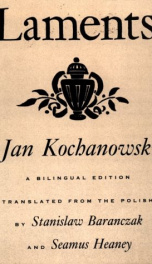Kochanowski Jan

Korwin Anna, née Białaczowska. Jan Kochanowski (1530 – August 22, 1584) was a Polish Renaissance poet who established poetic patterns that would become integral to Polish literary language. [1] He is commonly regarded as the greatest Polish poet as well as the greatest Slavic poet prior to the 19th century.[2] Kochanowski was born at Sycyna, near Radom, Poland. Little is known of his early education. At fourteen, fluent in Latin, he was sent to the Kraków Academy. After graduation in 1547 at age seventeen, he attended the University of Königsberg (Królewiec), in Ducal Prussia, and Padua University in Italy. At Padua, Kochanowski came in contact with the great humanist scholar Francis Robortello. Kochanowski closed his fifteen-year period of studies and travels with a final visit to France, where he met the poet Pierre Ronsard. In 1559 Kochanowski returned to Poland for good, where he remained active as a humanist and Renaissance poet. He spent the next fifteen years close to the court of King Sigismund II Augustus, serving for a time as royal secretary. In 1574, following the decampment of Poland's recently elected King Henry of Valois (whose candidacy to the Polish throne Kochanowski had supported), Kochanowski settled on a family estate at Czarnolas ("Blackwood") to lead the life of a country squire. In 1575 he married Dorota Podlodowska, with whom he had seven children. Kochanowski is sometimes referred to in Polish as "Jan z Czarnolasu" ("John of Blackwood"). It was there that he wrote his most memorable works, including The Dismissal of the Greek Envoys and the Laments. Kochanowski died, probably of a heart attack, in Lublin on 22 August 1584. Kochanowski never ceased to write in Latin, however his main achievement was the creation of Polish-language verse forms that made him a classic for his contemporaries and posterity. Kochanowski's first major masterpiece was Odprawa posłów greckich (The Dismissal of the Greek Envoys, 1578; recently translated into English by Indiana University's Bill Johnston). This was a blank-verse tragedy that recounted an incident leading up to the Trojan War. It was the first tragedy written in Polish, and its theme of the responsibilities of statesmanship continues to resonate to this day. The play was performed at the wedding of Jan Zamoyski and Krystyna Radziwiłł at Ujazdów Castle in Warsaw on January 12, 1578.[3] The masterpiece for which Kochanowski is best remembered is Treny (Threnodies, 1580, translated into English in 1995 by Stanisław Barańczak and Seamus Heaney as Laments). It is a series of nineteen elegies upon the death of his beloved two-and-a-half-year-old daughter Urszula. The Laments move the reader with their unaffected sentiments, expressed with a skill worthy, in a later generation, of a Shakespeare.
do you like this author?
What readers are saying
What do you think? Write your own comment on this book!
write a commentWhat readers are saying
What do you think? Write your own comment on this author!
write a commentBook list

Laments
Series:
Unknown
Year:
Unknown
Raiting:
4.5/5
A series of poems by Polish poet of Renaissance, written after the death of the author’s two-year-old daughter, are full of feeling of the loss and sorrow. These elegies express all the intensity of human grief and painful meditation of people’s fate; it brought about a great number of imitations during the ensuing years.
Show more
add to favoritesadd In favorites
Book list

Laments
Series:
Unknown
Year:
Unknown
Raiting:
4.5/5
A series of poems by Polish poet of Renaissance, written after the death of the author’s two-year-old daughter, are full of feeling of the loss and sorrow. These elegies express all the intensity of human grief and painful meditation of people’s fate; it brought about a great number of imitations during the ensuing years.
Show more
add to favoritesadd In favorites
What readers are saying
What do you think? Write your own comment on this author!
write a commentif you like Kochanowski Jan try:
readers also enjoyed
What readers are saying
What do you think? Write your own comment on this author!
write a commentif you like Kochanowski Jan try:
readers also enjoyed
Do you want to read a book that interests you? It’s EASY!
Create an account and send a request for reading to other users on the Webpage of the book!


